External links
| Classes | ||
|---|---|---|
| Physics of | ||
| Related | ||
| Progenitors | ||
| Remnants | ||
| Discovery | ||
| Lists | ||
| Notable | ||
| Research |
| |
The Monte Agliale Supernovae and Asteroid Survey (MASAS) is an offshoot of the Monte Agliale Supernovae Search (MASS), conducted from the Monte Agliale Astronomical Observatory at Monte Agliale near Borgo a Mozzano, Tuscany, Italy.
It has netted, on September 11, 2000 (IAUC 7494, September 22, 2000), the discovery by Matteo M. M. Santangelo of supernova SN 2000dl in the distant galaxy UGC 1191, near the center of the galaxy cluster Abell 240. The distance is estimated at 1,000,000,000 light-years, making it the 'first' most distant supernova discovered by an amateur.

A supernova is a powerful and luminous explosion of a star. A supernova occurs during the last evolutionary stages of a massive star, or when a white dwarf is triggered into runaway nuclear fusion. The original object, called the progenitor, either collapses to a neutron star or black hole, or is completely destroyed to form a diffuse nebula. The peak optical luminosity of a supernova can be comparable to that of an entire galaxy before fading over several weeks or months.
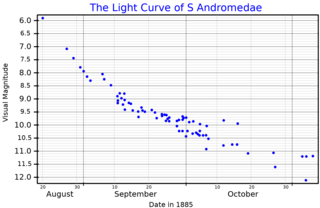
SN 1885A was a supernova in the Andromeda Galaxy, the only one seen in that galaxy so far by astronomers. It was the first supernova ever seen outside the Milky Way, though it was not appreciated at the time how far away it was. It is also known as "Supernova 1885".
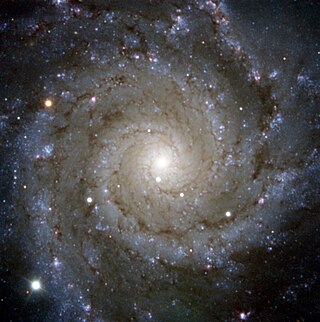
Messier 74 is a large spiral galaxy in the equatorial constellation Pisces. It is about 32 million light-years away from Earth. The galaxy contains two clearly defined spiral arms and is therefore used as an archetypal example of a grand design spiral galaxy. The galaxy's low surface brightness makes it the most difficult Messier object for amateur astronomers to observe. Its relatively large angular size and the galaxy's face-on orientation make it an ideal object for professional astronomers who want to study spiral arm structure and spiral density waves. It is estimated that M74 hosts about 100 billion stars.

NGC 3184, the Little Pinwheel Galaxy, is a spiral galaxy approximately 40 million light-years away in the constellation Ursa Major. Its name comes from its resemblance to the Pinwheel Galaxy. It has two HII regions named NGC 3180 and NGC 3181.

NGC 6946, sometimes referred to as the Fireworks Galaxy, is a face-on intermediate spiral galaxy with a small bright nucleus, whose location in the sky straddles the boundary between the northern constellations of Cepheus and Cygnus. Its distance from Earth is about 25.2 million light-years or 7.72 megaparsecs, similar to the distance of M101 in the constellation Ursa Major. Both were once considered to be part of the Local Group, but are now known to be among the dozen bright spiral galaxies near the Milky Way but beyond the confines of the Local Group. NGC 6946 lies within the Virgo Supercluster.
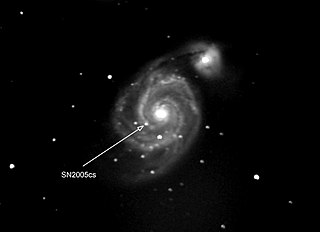
SN 2005cs was a supernova in the spiral galaxy M51, known as the Whirlpool Galaxy. It was a type II-P core-collapse supernova, discovered June 28, 2005 by Wolfgang Kloehr, a German amateur astronomer. The event was positioned at an offset of 15″ west and 78″ south of the galactic nucleus of M51. Based on the data, the explosion was inferred to occur 2.8 days before discovery. It was considered under-luminous for a supernova of its type, releasing an estimated 3×1050 erg in energy.
Robert Owen Evans, OAM was an Australian minister of the Uniting Church in Hazelbrook, New South Wales, and an amateur astronomer who holds the record for visual discoveries of supernovae (42).

A Type Ia supernova is a type of supernova that occurs in binary systems in which one of the stars is a white dwarf. The other star can be anything from a giant star to an even smaller white dwarf.

The known history of supernova observation goes back to 1006 AD. All earlier proposals for supernova observations are speculations with many alternatives.

SN 2006gy was an extremely energetic supernova, also referred to as a hypernova, that was discovered on September 18, 2006. It was first observed by Robert Quimby and P. Mondol, and then studied by several teams of astronomers using facilities that included the Chandra, Lick, and Keck Observatories. In May 2007 NASA and several of the astronomers announced the first detailed analyses of the supernova, describing it as the "brightest stellar explosion ever recorded". In October 2007 Quimby announced that SN 2005ap had broken SN 2006gy's record as the brightest-ever recorded supernova, and several subsequent discoveries are brighter still. Time magazine listed the discovery of SN 2006gy as third in its Top 10 Scientific Discoveries for 2007.
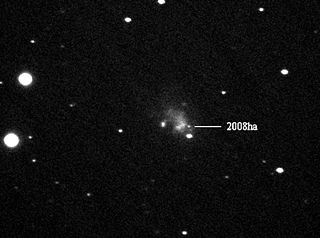
SN 2008ha was a type Ia supernova which was first observed around November 7, 2008 in the galaxy UGC 12682, which lies in the constellation Pegasus at a distance of about 21.3 megaparsecs (69 Mly) from Earth.
SN 2010lt is a supernova located in the galaxy UGC 3378 in Camelopardalis. It was discovered by amateur astronomers Kathryn Aurora Gray, her father Paul Gray, of Fredericton, New Brunswick, Canada and David J. Lane of Stillwater Lake, Nova Scotia, Canada. Upon discovery, Kathryn Aurora Gray became the youngest person to ever discover a supernova, being 10 years old when she did so. The previous record was held by the 14-year-old Caroline Moore.
SN 2011dh was a supernova in the Whirlpool Galaxy (M51). It was discovered on 31 May 2011, with an apparent magnitude 13.5. and confirmed by several sources, including the Palomar Transient Factory. A candidate progenitor was detected in Hubble Space Telescope images. The progenitor may have been a highly luminous yellow supergiant with an initial mass of 18-24 solar masses. The supernova peaked near apparent magnitude 12.1 on 19 June 2011. Emission spectra indicated that the explosion was a type II supernova, in which a massive star collapses once nuclear fusion has ceased in its core.
Doug Rich is an American amateur astronomer, supernova discoverer, and team leader for the Eagle Hill Supernova Search Project. He is also a former ZYGO optician and telescope maker and now lives in Hampden, Maine, USA. In 1999 he established Rich Observatory and has since discovered 26 extragalactic supernovae.

SN 2014J was a type-Ia supernova in Messier 82 discovered in mid-January 2014. It was the closest type-Ia supernova discovered for 42 years, and no subsequent supernova has been closer as of 2023. The supernova was discovered by chance during an undergraduate teaching session at the University of London Observatory. It peaked on 31 January 2014, reaching an apparent magnitude of 10.5. SN 2014J was the subject of an intense observing campaign by professional astronomers and was bright enough to be seen by amateur astronomers.
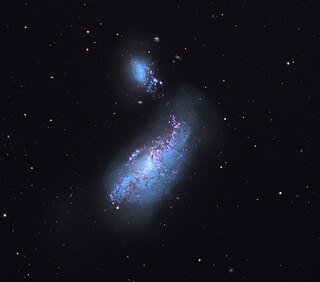
NGC 4490, also known as the Cocoon Galaxy, is a barred spiral galaxy in the constellation Canes Venatici. William Herschel discovered it in 1788. It is known to be of the closest interacting/merging galactic system. The galaxy lies at a distance of 25 million light years from Earth making it located in the local universe. It interacts with its smaller companion NGC 4485 and as a result is a starburst galaxy. NGC 4490 and NGC 4485 are collectively known in the Atlas of Peculiar Galaxies as Arp 269. The two galaxies has already made their closest approach and are rushing away from each other. It's been discovered that NGC 4490 has a double nucleus.

NGC 6753 is a massive unbarred spiral galaxy, seen almost exactly face-on, in the southern constellation of Pavo. It was discovered by the English astronomer John Herschel on July 5, 1836. The galaxy is located at a distance of 142 million light years from the Milky Way, and is receding with a heliocentric radial velocity of 3,140 km/s. It does not display any indications of a recent interaction with another galaxy or cluster.
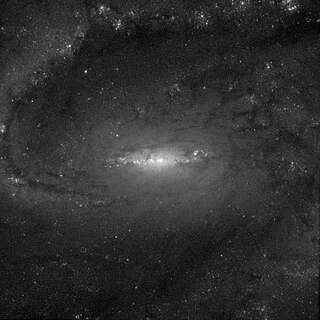
NGC 1255 is a barred spiral galaxy approximately 69 million light-years away from Earth in the constellation of Fornax.

UGC 9684 is a barred spiral galaxy with a bar and ring structure in the Boötes constellation. It is located 250 million light-years from the Solar System and has an approximate diameter of 90,000 thousand light-years.